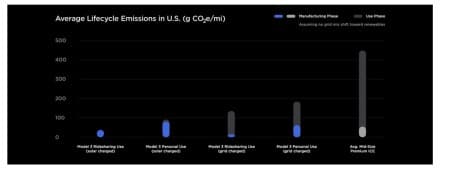Electric vehicle skeptics sometimes argue that the manufacturing and disposal of battery-electric vehicles like Teslas as well as reliance on coal to generate the electricity that powers them leaves EVs with a larger carbon footprint than nonelectric vehicles.
While that claim on the surface might sound absurd, it has a solid basis nonetheless because it has been proven that manufacturing and disposal of EVs results in significantly more greenhouse gasses than nonelectric models. However, that’s only part of the picture because most of the pollution associated with vehicles is linked to their on-road use over many years.
To determine the environmental costs of the trade-off, several universities and trade organizations have conducted life cycle analyses that compare the amount of greenhouse gasses created from the production, use and disposal of a B.E.V. vs. gasoline-powered vehicles of comparable size.
Vehicle emissions are divided into two general categories: air pollutants, which contribute to health problems and greenhouse gasses (GHGs), such as carbon dioxide and methane. Both categories of emissions are frequently evaluated on a tailpipe basis, a well-to-wheel basis, and a cradle-to-grave basis. Well-to-wheel emissions are emissions related to fuel production, processing, distribution and use while cradle-to-grave emissions include well-to-wheel emissions as well as vehicle-cycle emissions associated with vehicle and battery manufacturing, recycling, and disposal.
The good news: whereas these studies have arrived at varying emission figures, they have invariably found that the greenhouse-gas emission difference caused by the carbon-intensive production of BEVs vs. ICE vehicles is virtually erased in the first few years of an EVs life.
In one such study conducted by the University of Michigan, it takes 1.4 to 1.5 years for EV sedans to erase the pollution advantage of ICE vehicles due to the manufacturing process; 1.6 to 1.9 years for S.U.V.s and about 1.6 years for pickup trucks. These numbers are based on the average number of vehicle miles driven in the United States.
According to the study, on average, emissions from B.E.V. sedans are ~35% of the emissions from an internal-combustion sedan; electric S.U.V.s produce ~37% of the emissions of a gasoline-powered vehicle while B.E.V. pickups create ~34% of the emissions of an internal combustion model. All-electric vehicles, plug-in hybrid electric vehicles (PHEVs), and hybrid electric vehicles (HEVs, which operate as EVs for limited distances), produce lower tailpipe emissions than ICE vehicles, and zero tailpipe emissions when they run only on electricity.
Electricity Generation
Even though all-electric vehicles as well as PHEVs running only on electricity produce zero tailpipe emissions, electricity production may generate emissions depending on how the electricity is generated.
According to Greg Keoleian, director of the Center for Sustainable Systems at the University of Michigan, 78 of the 3,143 counties in the United States actually have more emissions from electric sedans than from internal combustion vehicles because they generate most of their electricity by burning coal.
But overall, electric vehicles are much kinder on the environment than ICEs.
According to the U.S. Department Of Energy, the average all-electric vehicle in the U.S. produces 2,817 pounds of CO2 equivalent per year; plug-in hybrids emit 4,824 pounds of CO2 equivalent, hybrid vehicles generate 6,898 pounds while gasoline-powered vehicles produce 12,594 pounds of CO2 equivalent per year.

Source: U.S. Department Of Energy
The Tesla Juggernaut
In Tesla’s latest Impact Report, the company says it has implemented full vertical integration in its manufacturing process to minimize its emissions profile. The EV maker says that Tesla cars can convert electricity into power more efficiently than other equivalent EVs, and claims that the Model 3 Standard Range Plus (SR+) is the most energy-efficient vehicle on the market.
When it comes to battery disposal, Tesla says that few Tesla batteries, even from older models, have been decommissioned to-date because its battery packs are designed to outlast the vehicle itself. The company says that in preparation for the future, its battery factories have begun implementing an in-house, closed-loop recycling system that will recycle all types of Tesla batteries and re-use up to 92% of their raw metals.
Tesla says that in 2020, its cars saved 5.0 million metric tons of CO2e emissions, equal to the emissions of ~1.1 million automobiles or about the same as the yearly emissions of the state of Vermont.

Source: Tesla
By Alex Kimani for Oilprice.com
More Top Reads From Oilprice.com:
- Copper Prices Stuck In Limbo
- Inflation Reduction Act Leads To Record Spending On New U.S. Factories
- Exxon: Decarbonization Business Is Set For Huge Growth


















